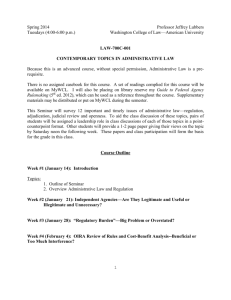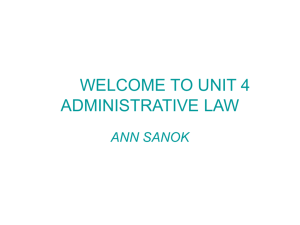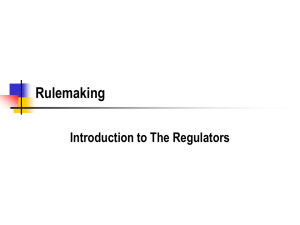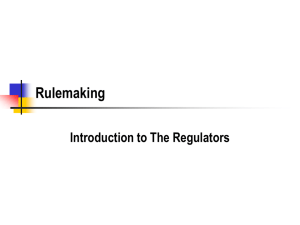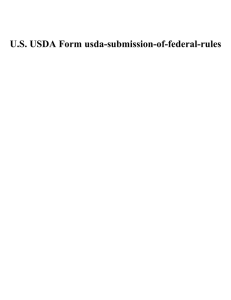Chapter 5 III
advertisement
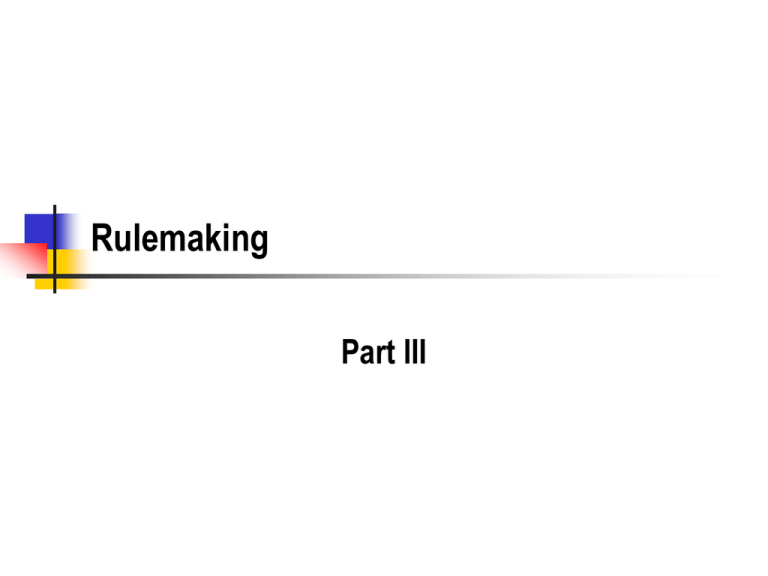
Rulemaking Part III Limits on Logical Outgrowth - Arizona Public Service Co. v. E.P.A. What did the EPA propose that Indian Tribes be allowed to do that states were doing? State plans are subject to judicial review - Why did the tribes object to this in comments? How was the rule changed? What was the claim by plaintiffs? How did the court analyze the problem? Why shouldn't have been a surprise? 2 What about Technical Information Underlying the Rule? (not in book) Portland Cement v. Ruckelshaus, 486 F2d 375 (1973) The agency must disclose the factual basis for the proposed rule, if it relied on scientific studies or other collections of information Connecticut Light and Power v. NRC, 673 F2d 525 (1982)? The agency cannot hide technical information. Why is this a big deal in environmental regs? What are the potential downsides of this policy? 3 Shelby Amendments to the Freedom of Information Act (not in book) As we will learn later, the FOIA traditionally applied only to information in possession of government agencies Senator Shelby, at the urging of several business lobbies, successfully extended FOIA to information produced by federally funded research and in the hands of universities Why would business lobbies want access to this information, esp. in environmental rulemakings? Why might such access be a problem for professors? 4 Additions to the Published Record (not in book) Rybachek v EPA EPA added 6000 pages of supporting info when responding to comments Court said the agency may supplement the rulemaking record in response to comments asking for explanation Idaho Farm Agency added a report to the record, then relied on it in the final rule. The agency may not add new material and then rely on it without given an opportunity to comment on it. 5 Negotiated Rulemaking What is this? Why is often used in environmental rulemaking? What are the advantages? What are the public participation issues? 6 Ex Parte Communications Rulemaking How does the notice provision in rulemaking change the issues in ex parte communications? How does the notice requirement eliminate the ex parte communications issues for communications before the promulgation of the rule? When are ex parte communications an issue? How can you cure this? 8 Bias and Prejudice Remember the cases on bias of decisionmakers in adjudications? Should these also apply to rulemaking? How does notice and comment change the situation? 9 Association of National Advertisers , Inc. v. FTC FTC is adopting rules on TV advertising directed at children Chairman has written and spoken at length on the evils of TV ads aimed at children Plaintiffs seek to disqualify him because of bias Court held that plaintiffs must show clear and convincing evidence that he has an unalterably closed mind on matters critical to the rulemaking No rulemaking has ever been overturned on the basis that a decisionmaker was unlawfully prejudiced. 10 DC Federation of Civic Associations v. Volpe, 459 F.2d 1231 (D.C. Cir. 1971) The Volpe test for whether a rulemaking may be overturned solely on evidence of Congressional pressure 1) was there specific pressure on the agency to consider improper factors? 2) did the agency in fact change its mind because of these considerations? How can the agency defend itself from a Volpe attack? What did the Court Rule when it applied Volpe to this Case? Why is it proper for congressmen to comment on proposed rules? 11 Sierra Club v. Costle, 657 F.2d 298 (D.C. Cir. 1981) Rule making on coal fired power plants Why is this controversial then and more so now? Sierra Club claimed that the president influenced the agency Is that wrong? What is the cure? Senator Bird also weighed in What do plaintiffs need to show to establish undue influence? Why is an outcome test, combined with the record, a good solution? 12 What is the president's role in rulemaking? Controls and supervises executive branch decisionmaking What just happened with the ozone regs? How is the role different in adjudications? When should the president's contacts be documented? When the statute requires that they be docketed If the rule is based on factual information that comes from such a meeting. 13 Should State Rules Differ from Federal Rules on Notice and Comment? Limited staff Greater reliance on the expertise of board members, rather than staff Board may hear lots of testimony and review a lot of info - they cannot afford the time and effort to put together volumes of supporting info for regs What about LA's 300+ tiny boards? Should state agencies have a reduced publication requirement? Should they be able to publish rules without explanation and only have to explain if asked? 14 Congressional Mandates (Hybrid Rulemaking) at the FTC issue an advance notice of proposed rulemaking, which describes the area of inquiry under consideration and invites comments from interested parties; send the advance notice and, 30 days before its publication, the notice of proposed rulemaking to certain House and Senate committees; hold a hearing presided over by a hearing officer at which persons may make oral presentations and in certain circumstances to conduct cross-examination of persons; include a statement of basis and purpose to address certain specified concerns; and conduct a regulatory analysis of both the proposed and final rules that describes the proposal and alternatives that would achieve the same goal and analyzes the costs and benefits of the 15 proposal and the alternatives. Executive Orders Regulating Rulemaking What is the president's authority over rulemaking? What about for independent agencies? Why should the president exercises authority over rulemaking? Coordination of agencies? Assuring that the agencies carry out the administration's objectives? 16 Acronyms OMB - Office of Management and Budget OIRA - Office of Information and Regulatory Affairs 17 Executive Order 12866 OIRA must review rules that have an impact of more than 100M aggregate or substantial impact on a segment of the economy or any thing else. 18 The Regulatory Philosophy Federal agencies should promulgate only such regulations as are required by law, are necessary to interpret the law, or are made necessary by compelling public need, such as material failures of private markets to protect or improve the health and safety of the public, the environment, or the well-being of the American people. In deciding whether and how to regulate, agencies should assess all costs and benefits of available regulatory alternatives, including the alternative of not regulating. 19 CBA under 12866 Costs and benefits shall be understood to include both quantifiable measures (to the fullest extent that these can be usefully estimated) and qualitative measures of costs and benefits that are difficult to quantify, but nevertheless essential to consider. 20 Choosing Among Alternatives Further, in choosing among alternative regulatory approaches, agencies should select those approaches that maximize net benefits (including potential economic, environmental, public health and safety, and other advantages; distributive impacts; and equity), unless a statute requires another regulatory approach. Pretty simple? :-) 21 What must the agency provide OIRA - I An assessment, including the underlying analysis, of benefits anticipated from the regulatory action (such as, but not limited to, the promotion of the efficient functioning of the economy and private markets, the enhancement of health and safety, the protection of the natural environment, and the elimination or reduction of discrimination or bias) together with, to the extent feasible, a quantification of those benefits; 22 What must the agency provide OIRA - II An assessment, including the underlying analysis, of costs anticipated from the regulatory action (such as, but not limited to, the direct cost both to the government in administering the regulation and to businesses and others in complying with the regulation, and any adverse effects on the efficient functioning of the economy, private markets (including productivity, employment, and competitiveness), health, safety, and the natural environment), together with, to the extent feasible, a quantification of those costs; 23 What must the agency provide OIRA - III An assessment, including the underlying analysis, of costs and benefits of potentially effective and reasonably feasible alternatives to the planned regulation, identified by the agencies or the public (including improving the current regulation and reasonably viable nonregulatory actions), and an explanation why the planned regulatory action is preferable to the identified potential alternatives. 24 12866 and Rulemaking What if the statute says no CBA - can the president impose it anyway? Why is there a special provision for analyzing impact on small businesses? Does an executive order create private rights, i.e., can you challenge an agency's OIRA showing? 25 Statutory Requirements National Environmental Policy Act imposes requirements if the rule affects the environment Regulatory Flexibility Act - small business Only direct effect on small business Rules on small truck standards might affect small business owners, but since it is directed at manufacturers, small business owners do not have standing Paperwork Reduction act - every rule that requires reporting must be reviewed CDC newsletter cannot ask for reader feedback Statutory requirements can create private rights 26 Congressional Review Most rules, including those exempt from notice and comment, must be reported to Congress, which has 60 days to review them There is a provision for emergency rules What can Congress do if it does not like the rule? When is this likely to happen? What about independent agencies? Why does this law not violate separation of powers? 27 Information Quality Act Requires OMB to adopt guidelines ensuring and maximizing the quality, objectivity, utility, and integrity of information (including statistical information) disseminated by Federal agencies Why is this a redundant requirement? What could be the purpose of this requirement? 28 Unfunded Mandates What is an unfunded mandate? How is this stealth regulatory reform? Unfunded Mandates Act of 1995 - Agency must do a CBA if the costs exceed 100M What would be the impact of banning unfunded mandates? What are the types and impact of unfunded mandates on public schools? 29 How do these CBA and Review Requirements Affect Agencies? Who benefits? Who loses? What is the financial impact? Remember the rules: Cost effective Effective regulation Due process and fairness to regulated parties Pick two 30
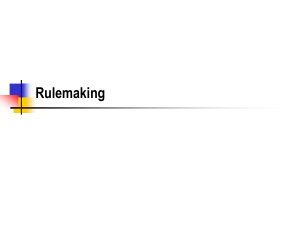
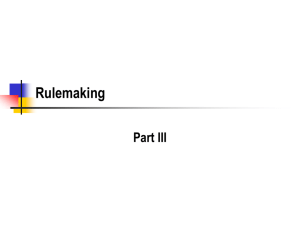
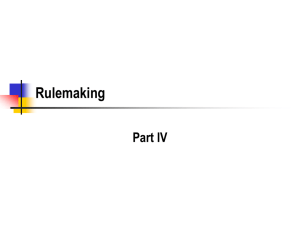
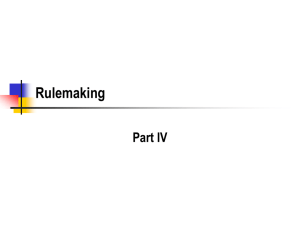
![Minnesota Department of [Name] MEMORANDUM](http://s2.studylib.net/store/data/015049440_1-475d22d0ab7bd661c71329dec0ae8429-300x300.png)
